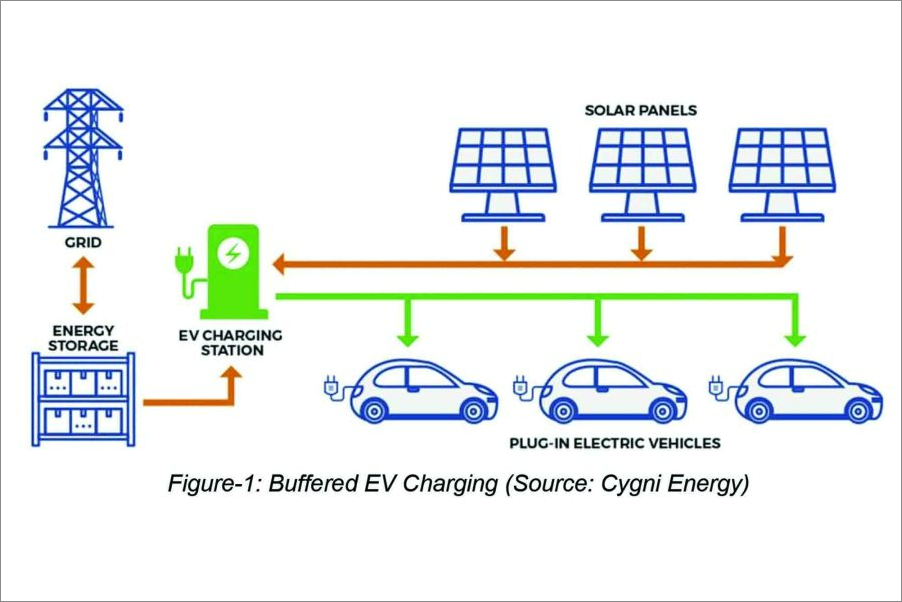Ultra-fast EV charging a new load challenge to the grid
By Staff Report July 1, 2025 2:17 pm IST
By Staff Report July 1, 2025 2:17 pm IST

Local generation (wind or solar) and storage, coupled with fast charging infrastructure, is also becoming a widely accepted model known as buffered EV charging.
With the evolution of battery technology, ultra-fast charging (ranging from 150kW to 600kW) is likely to become a mainstay feature of EVs as they aim to counter range anxiety. For instance, the recently launched Mahindra XEV 9e supports 180 kW DC fast charging and can achieve a range of approximately 400 km in just 20 minutes. This scales to a MW level when we consider fast charging for larger commercial vehicles. For context, a typical residential complex with approximately 250 flats has a demand of around 1MW on the grid, but this demand is much more predictable. In contrast, EV charging loads are significantly more sporadic and difficult to predict. This is the crux of the challenge that fast charging poses to grid stability – concentrated but ad hoc pockets of power demand that could destabilise local networks while also making generation-related planning more complex.
Optimising EV Charging
While there is, unfortunately, no silver bullet, the good news is that there are synergies in our approach to integrating renewables into our energy mix and our plan to enable fast charging for electric vehicles (EVs). Fundamentally, both require a higher degree of decentralisation, intelligent grids, integration of energy storage to buffer against intermittency (whether on the generation side or the load side) and smart pricing, which can influence consumption behaviours.
Let us unpack some of these in more detail. Local generation (wind or solar) and storage, coupled with fast charging infrastructure, also known as buffered EV charging is becoming a widely accepted model. The batteries support the bulk of the ad hoc power demand of the chargers and this is complemented by power from renewables and a significantly lower-capacity grid connection. The ad hoc pockets in the demand and generation side are addressed by the storage.
The additional cost of storage is offset by lower contract demand charges, cheaper power generation costs from solar, and significantly lower local distribution infrastructure costs (such as transformers and cabling). This is especially true for highways or remote regions where the infrastructure cost of meeting high contract loads could be prohibitively high.
A complementary strategy is to shape customer demand through incentives to encourage charging during off-peak hours, which also ensures optimal utilisation of the grid. For instance, as solar generation capacity has increased, there has been a significant surplus of power during the afternoon hours, resulting in low tariffs for developers. EV fast-charging loads could be moved to these slots by passing on the low tariffs to customers. The Kerala State Electricity Regulatory Commission (KSERC) recently approved a time-of-day tariff for EV charging during solar hours (9 AM to 4 PM), when users can avail of 30 per cent lower tariffs.
The other mechanism requires better planning of fast-charging infrastructure, including distributed charging control and higher interoperability. This trifecta can ensure more dispersed usage and minimise the development of local hotspots of demand, which could result in grid outages. The charging control, especially for scheduled charging loads, will enable throttling and provide DISCOMs with additional flexibility in dealing with demand.Cybersecurity Challenges
With the increasing interconnectivity of charging and grid infrastructure, we face higher risks related to cybersecurity. Cybersecurity firm Upstream identified over 295 cybersecurity incidents in the automotive and mobility sector in 2023, representing a sharp 50 per cent increase over the previous year. Similarly, the regulator in the UK enforced the removal of a brand of electric vehicle (EV) chargers, which were found to have a known vulnerability to hacking. These attacks can impact electric vehicles (EVs) and also disrupt grid operations. The Indian authorities should enforce relevant cybersecurity standards (ISO/IEC 15118, IEC 62443, etc.) to mitigate this risk.
To conclude, we can say that ensuring grid stability with fast EV charging needs a balanced mix of local renewables and storage.
******************************************
Authored by:
Gautam Patil, Head- Strategy & Investments, Cygni Energy
We use cookies to personalize your experience. By continuing to visit this website you agree to our Terms & Conditions, Privacy Policy and Cookie Policy.